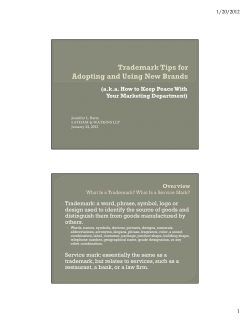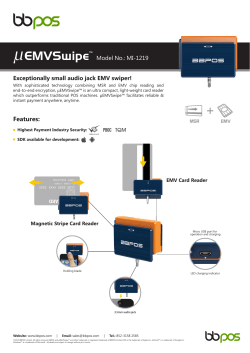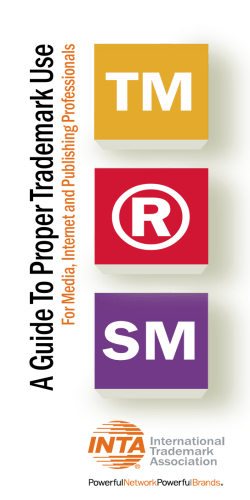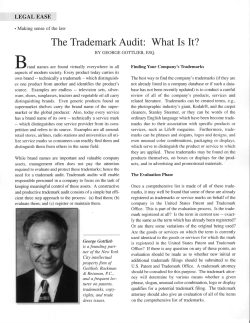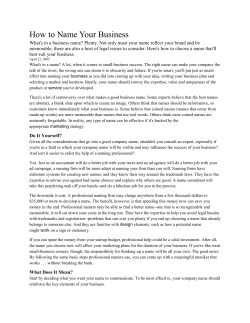
Document 203833
Marunouchi Mitsui Building, 2-2-2 Marunouchi, Chiyoda-ku Tokyo 100-0005, Japan Fon: + 81-3-6212-5500 Fax: +81-3-6212-5700 http://www.city-yuwa.com Legal Updates of Japan June 6, 2012 This is a brief introduction to the Japanese Trademark Law and its enforcement. 1. Kinds of Trademarks Trademarks in Japan consist of trademarks for goods and trademarks for services. Both types of trademarks are treated the same in terms of application, registration and enforcement, etc. 2. Classes of Goods and Services Japan has adopted the International Classifications and currently goods are classified into 34 classes and services are classified into 11 classes. 3. Trademark right A trademark right is created upon registration at the Patent Office. The owner of an unregistered mark has no exclusive right to use the mark under trademark law. However, if the mark is well known, it will be protected against unauthorized use under the Unfair Competition Prevention Law. 4. Application for Registration Applications are filed with the Patent Office on-line and the examination takes 8 to 10 months. In case an infringement is threatened or there are other legitimate reasons, the applicant may request a fast-track examination, in which case the application will be examined very quickly (about 2 months). No power of attorney is necessary. If the Examiner determines that the mark shall not be registered, the Examiner gives notice of the reason for refusal to the applicant. The applicant may challenge the determination not to register the mark or amend the application within three months (for foreign applicants). 5. Compensation Claim for Unauthorized Use During the Application Period Generally, no rights are created when the application for registration of the trademark is pending. However, if the applicant learns of a third party’s use of the mark during the examination period, the applicant may give notice of the application to such third party and if the third party continues to use the mark after notice, the applicant may make a claim for a reasonable royalty as compensation for the third party’s use of the mark during the period between the date of notice of application and the date of registration of the mark, provided that the application is accepted and the mark is registered. 6. Examination of Trademarks The mark will be registered if the examiner does not find any reason to refuse the application. One of the most common reasons for refusing an application is that there is a prior registration which is confusingly similar to the applied for trademark in the same “Similar Group Codes”, which haven been established by the Patent Office based upon the old Japanese classifications. The English version of the Similar Group Codes is published by the Japan Institute of Invention and Innovation. The similarity test of trademarks is conducted according to court precedents and standards established by the Patent Office. It is especially likely that a mark will not be registered based on a finding that it is confusingly similar to a previously registered mark if the two trademarks are similar in terms of pronunciation, meaning or appearance. Words used for Japanese trademarks include Japanese phonetic writing (hiragana or katakana), Kanji Characters and/or Western letters. For example, a new application for “TIMEVISION” or “TIME VISION” will likely be refused as there is a trademark registration of “taimubijon” in katakana in the same Similar Group Code which is deemed to be similar to “TIMEVISION” and “TIME VISION” in the pronunciation. 7. Official Fees for Application and Registration (1) Multiple Applications The official fee for an application for the registration of one trademark with respect to multiple International Classes is ¥12,000 for the first class and ¥8,600 for each additional class. (2) Single Applications The official application fee is ¥12,000 for each International Class if a separate application is filed with respect to each International Class. As indicated above, a single application covering multiple classes is more economical, but if the Patent Office finds a cause for refusal in any class, then the entire application would be rejected and the applicant must separate the application into separate applications so that the applicant may have the trademark registered earlier with respect to the accepted class, which may result in more cost and some 2 delay. (3) Registration If the trademarks are registered, the official fee for registration is ¥37,600 for 10 years and ¥21,900 for 5 years per trademark and class. (4) Renewal of Registered Trademark Trademark registrations are renewed every ten years. No evidence for use is required for the renewal. The official fee is ¥48,500 for 10 years and ¥28,300 for 5 years per trademark and class. 8. License Under the Japanese Trademark Law, there are two types of licenses: (A) ordinary license (Tsujo-Shiyo-Ken) (“Ordinary License”); and (B) special license (Senyo-Shiyo-Ken) (“Special License”). Ordinary Licenses may be exclusive or non-exclusive according to the agreement between the parties concerned. Special Licenses seem to be unique to Japan. A Special License is similar to, but stronger than, an exclusive Ordinary License. The Special Licensee has the exclusive right to use the trademark for the designated goods within the scope specified in the license agreement, and even the trademark owner is prohibited from using the trademark within said specified scope. The Special Licensee may, in its name and for its interest, make claims against any infringer of the trademark for the cessation of the use of the trademark and for compensation for any damages incurred due to infringement. Meanwhile, the question is open as to whether an Ordinary Licensee with an exclusive license may make such claims in its name and for its interest because the effect of the license is generally limited to the contracting parties (An Ordinary Licensee with a non-exclusive license is not be entitled to make such claims). The Special License becomes effective only upon the registration thereof at the Patent Office, while the creation of an Ordinary License does not require registration at the Patent Office or any formality other than the agreement between the parties. However, the Ordinary Licensee, whether through an exclusive or non-exclusive Ordinary License, may assert his license against any potential assignee of the trademark or Special Licensee only after the Ordinary License is recorded at the Patent Office. A party that infringes on the use of a registered trademark is subject not only to an injunction and damages to the trademark owner (or Special Licensee), but also subject to imprisonment of not more than 10 years and/or a fine of not more than ¥10,000,000. 9. Parallel Import The parallel import of genuine goods from sources other than the authorized distributor is not prohibited. As the function of trademark is to identify the source of goods and guarantee the quality of products (that is, the quality of goods supplied under the same trademark shall be the same), the court cases have 3 generally held that the importation and distribution of genuine goods through sources other than the authorized distributor shall not be deemed to infringe trademark rights. 10. Measures against Counterfeiting (1) If any counterfeiting is recognized, the following measures can normally be utilized: (i) sending a warning letter to the counterfeiter: (ii) filing an application for a provisional injunction: (iii) initiation of a lawsuit for injunction and compensation for damages: (iv) filing a criminal complaint with the public prosecutor or the police: (v) application to the administrative authorities for the prohibition of import of counterfeit goods. (2) Warning letter There is no legal requirement to send a warning letter to a counterfeiter demanding that they immediately cease the infringement and warning that legal action will be taken if they fail to cease the infringement. However, such warning letter is often very effective, especially if an attorney-at-law sends it by content-registered mail. Because such letter by an attorney-at-law is generally deemed as the first step of a legal action, it is understood that legal action will be actually initiated if the counterfeiter ignores the warning. A content-registered letter does not seem to be available in other countries. This is different from a mere registered letter, which only registers the delivery of letter to the addressee. It registers the contents of the letter and the delivery of such letter. In order to send a content-registered letter, three copies of the letter must be prepared in the form prescribed by postal regulations and brought to a post office. It will work as satisfactory evidence as to the receipt of such letter by the defendant in a possible future lawsuit. (3) Provisional injunction An ordinary lawsuit is a slow and lengthy process in Japan. Therefore, the Law of Civil Preservation provides for a provisional injunction in order to preserve an applicant’s rights pending final determination of a controversy. When applying for a provisional injunction, the applicant must present prima facie evidence as to the existence of their claim and the necessity of the provisional injunction. The judge usually hears arguments from the defendant before the issuing the injunction order, as such order, once issued, will seriously affect the business and existence of the defendant. If and when the court decides to issue injunction order the applicant will be required to deposit a certain amount of money with the court. This deposit is a guarantee for possible damages to the defendant caused by the wrongful acquisition of an injunction, which damages would have to be provided in a separate suit, by the 4 defendant if the defendant seeks damages against the applicant. The court will determine the amount of the deposit based upon the circumstances. (4) Lawsuit for injunction and compensation for damages An IP lawsuit usually takes one or two years in the first instance until the judgment is rendered. The suit begins with the submission of a complaint by the plaintiff, and an answer is submitted by the defendant. Thereafter briefs are exchanged between the parties and evidential documents are submitted in oral court sessions which are generally held at about one month intervals. After the points at issue become clear to the court, the court examines witnesses and experts and the parties themselves if it considers necessary. (5) Criminal complaint to the public prosecutors or the police There are some individuals and companies that habitually counterfeit others’ goods, especially goods with famous foreign brand names. As they usually act behind the scenes, civil legal actions are at times ineffective, even putting aside the time and cost involved in the civil legal action. A trademark owner or Special Licensee is entitled to make a criminal complaint to the public prosecutors or the police if their rights are infringed by an act which constitutes a crime. (6) Application for prohibition of import of counterfeit goods to the administration offices Article 69 of the Customs Law prohibits the import of goods which infringe a patent, utility model rights, a design patent, trademark, copyright, or neighboring rights, etc. and the chief of a customs office may confiscate such goods or order the importer to ship them back. Accordingly, it may be advisable to request the customs office to take such action if any infringing goods are imported in Japan. Actions of the customs offices seem to be effective. As mentioned above, however, the import of genuine goods through a source outside of the authorized distributor cannot be stopped from entering Japan because the import of genuine goods is not deemed to constitute the infringement of trademark rights. (7) Determining the best action to take Determining the proper course of action depends on the circumstances of a given case. A warning letter is often effective, but when the counterfeiter is acting behind the scenes they may be difficult to locate. Using the courts is an alternative but depending on the circumstances an injunction may not be issued and the court action may take much time and expense. Involving the police or customs authorities may be appropriate in some case. Of course, a combination of actions may prove to be the best and most effective course of action in the end. 5
© Copyright 2025
